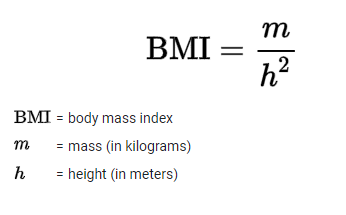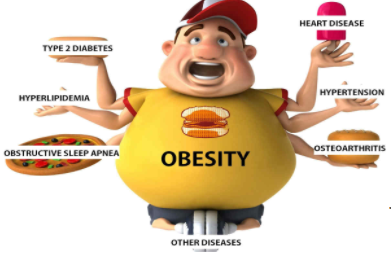Objective Overview
Obesity is a global matter and its trend in the 21st century helps unveil valuable information that researchers can analyze and push into other fields like the medical and food industry. Recently, the emerging of the COVID-19 pandemic makes this matter an even more pressing issue. Factors like depression from job loss, stressful family environment, economic hardship, etc., can all lead to obesity. Those introduced into the equation further perplex the overall dynamic of resolving and understanding obesity as a global issue. This study's fundamentals are to establish a preliminary understanding of the current situation of obesity globally and its adverse effect on the human body and possible remedies for weight loss that can be applied to the mass population.
Each person has a weight, which is usually something one uses to gauge his or her health situations. Most people typically consider obesity to be overweight, and the train of thought is to lose weight by eating less and exercise more. The definition of obesity itself is not necessarily one single term. According to the Center for Disease Control and Prevention(CDC) source, in the United States, obesity symptoms from human differs from person to person. It is categorized using the Body Mass Index (BMI) formula into six different groups:
- 0 - 18.5, underweight
- 18.5 - 24.9, normal or heavy weight
- 24.9 - 29.9, overweight
- 29.9 - 35, obese class 2, low risk
- 35 - 40, obese class 2, moderate risk
- 40 - infinite, obese class 3, high risk
The BMI formula uses both the height of the person and the person's weight, and the outcome is determined by the weight divided by the height squared. A snapshot below should demonstrate the computation:

The benefit of the differentiated obese levels is that it clarifies the level of risk the person carries. A side note is that for athletes or people who have higher muscle mass, as muscle mass weighs more than fat tissue, a single BMI calculation may not be the optimal way to gauge one`s overall obese level. To measure the muscle mass and fat percentage of a person requires high precision lab equipment that is not entirely accessible to the general public, thus using BMI here for its practicality.
Findings
Firstly, the overall trend of the global obesity rate steadily increasing for the past 40 years. A report of international obese population data indicates that most developed countries see an upward trend in the nation's obese population for both sexes. Surprisingly, the data also shows some developing countries in the Middle East tripled their obese people in 2016 compared to 1975. The geographic distribution shows a higher obese population in North America and South America, while Southeast Asia has a lower obesity rate.
Global obesity rate increased can be attributed to a lower poverty rate and higher living conditions for both developed and developing countries. The more obese population in North America can be attributed to the dietary culture and the high disperse between the rich and the poor. People who have less money consume worse quality food with more added hormones to meat and vegetables, leading to unhealthy body or obesity. The study does not dive into different races since there isn't enough evidence to support insightful outcomes.
Most people are still in good shape, even for people who have health issues like acute liver failure and cardiac disease. The majority of those patients still reside from normal weight to obese class 2, moderate risk level, which means obesity may not be the only factor that causes those detrimental organ malfunctions. Some other possible aspects can be the age and existing health conditions and physical activity levels. Additionally, an attempted study of people who experience obesity at a younger age has persistent obese symptoms, but not enough evidence can support the claim.


(Left source: https://www.sanolife.co.uk/childhood-obesity/; Right source: https://www.progressivecare.in/obesity/)
As to possible ways to reduce the obesity rate, the techniques should be specific for each individual. Study shows a successful weight loss program should incorporate seventy to eighty percent on nutrition and food intake, and the rest on workout or exercise options. Most people overlooked the benefit of having a good nutrition plan and blindly following a diet plan. Not only because starving or eating way less of your basal metabolic rate is unhealthy and should be customized individually, but a painful diet will not be sustainable in the long term; the weight will take itself back. Ketogenic diet and intermittent fasting are the most popular weight-loss dietary options. The popular trend is to eat more protein and less starchy carbs each day. Simply divide a plate into forty percent protein, forty percent vegetables, and twenty percent carbs. Intermittent fasting is to limit the amount of time you are eating at a specific window. The most popular is 16 by 8, which means that 8 hours you can eat and the rest 16 stay away from food. Study shows fasting for longer than 16 hours triggers a metabolic effect that accelerates fat burning and less craving for food. This study's data proves the positive feedback from Reddit users who incorporate 16 by eight intermittent fasting with a ketogenetic diet.
Ending Thoughts & Future Improvements
When the world is going to accelerate with the fourth industrial revolution powered by machine learning and artificial intelligence, more possibilities and findings can be excavated. In this study's scope, improvement can be made on the data collected. For example, time-series data that spans over decades will help determine the overall effect of obesity at different stages of a person's life. Although the conclusion focused on the comprehensive research and analysis on this specific topic, this study can still benefit from more development in the future.